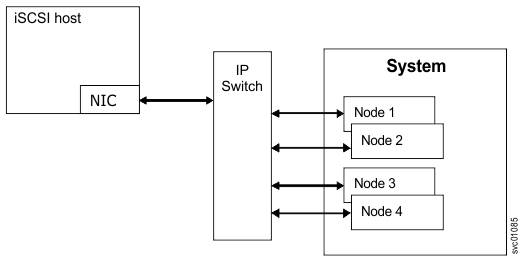iSCSI is an IP-based standard for transferring data that supports host access by carrying SCSI commands over IP networks. The iSCSI standard is defined by RFC 3720.
Connections from iSCSI-attached hosts to system nodes are supported. iSCSI connections from system nodes to Lenovo V series, Spectrum Accelerate, and Dell EqualLogic systems that are used as external storage systems are also supported.
Table 1 shows that iSCSI and Fibre Channel terms have analogous components.
| iSCSI components | Fibre Channel components |
|---|---|
| iSCSI host bus adapter | Fibre Channel host bus adapter |
| Network interface controller (NIC) and iSCSI software initiator | Fibre Channel host bus adapter |
| IP switch | Fibre Channel switch |
| IP router | – |
| iSCSI name, such as IQN (iSCSI qualified name) or EUI (extended-unique identifier) | WWNN (worldwide node name) |
iSCSI initiators and targets
In an iSCSI configuration, the iSCSI host or server sends requests to a node. The host contains one or more initiators that attach to an IP network to initiate requests to and receive responses from an iSCSI target. Each initiator and target are given a unique iSCSI name such as an iSCSI qualified name (IQN) or an extended-unique identifier (EUI). An IQN is a 223-byte ASCII name. An EUI is a 64-bit identifier. An iSCSI name represents a worldwide unique naming scheme. This scheme identifies each initiator or target in the same way that worldwide node names (WWNNs) are used to identify devices in a Fibre Channel fabric.
iSCSI targets are devices that respond to iSCSI commands. An iSCSI device can be an end node such as a storage device, or it can be an intermediate device such as a bridge between IP and Fibre Channel devices. Each iSCSI target is identified by a unique iSCSI name. The system can be configured as one or more iSCSI targets. Each node canister that has one or both of its node Ethernet ports that are configured becomes an iSCSI target.
To transport SCSI commands over the IP network, an iSCSI driver must be installed on the iSCSI host and target. The driver is used to send iSCSI commands and responses through a network interface controller (NIC) or an iSCSI HBA in the host or target hardware.
For maximum performance, use a gigabit Ethernet adapter that transmits 1000 megabits per second (Mbps) for the connection between the iSCSI host and the iSCSI target.
iSCSI host connection options

iSCSI multisession support
Multisession support, or host-level multipath support, provides multiple paths between iSCSI initiators and targets, which is useful for high availability and load balancing.
Some products require that an iSCSI initiator login with a specific IP address of the target versus logging in with a target name. Logging in with a target name in those products causes the iSCSI initiator to log in to all of the IP addresses in the target and causes session reinstantiation that results in session loss of the previous login.
The system offers single subnet multi-session configurations and multiple and dual subnet multisession configurations that remove the restriction against logging in to a target name. iSCSI initiators use Internet storage name service (iSNS) servers to log in, which enables the discovery of the iSCSI targets and their IP addresses.
iSCSI storage support
The system supports iSCSI connections to Lenovo V series and Dell EqualLogic systems that are used as external storage systems. For specific configuration information, see External storage system configuration with iSCSI connections.
Discovery and path configuration for iSCSI controllers is done as follows: